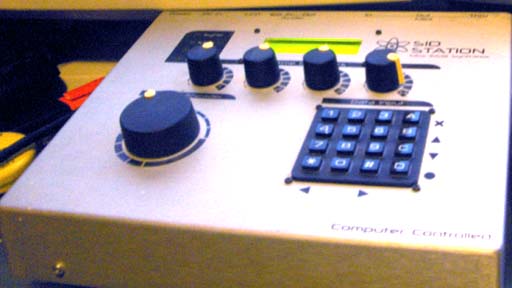- Elektron SidStation
Infobox_synthesizer

image_caption = SidStation, standard model
synth_name = SidStation
synth_manufacturer = Elektron
synthesis_type = Analog Subtractive
polyphony = 1 or 3
timbrality =Monotimbral
oscillator = 3
filter = 1 (analog)
attenuator =
left_control = 4x realtime rotaries
lfo = 4
keyboard = numeric keypad| memory =
ext_control =MIDI
fx =
dates =1999 -2006
price =US$ 950The Elektron SidStation is a musical
synthesizer sound module , built around theMOS Technology SID mixed-mode synthesizer chip originally used in theCommodore 64 home computer. It was produced by the Swedish synthesizer company Elektron, and was introduced in1999 . As the SID chip had not been manufactured for years, Elektron allegedly bought up nearly all the remaining stock.The company built the SidStation until
2003 , when their initial supply of SID chips ran out. The last 100 units sold, the Final 100 Edition, were laser etched with a number on the front panel's bottom-left corner and sold in descending order from 100 to 1. In March of2005 , Elektron encountered an additional supply of 100 SID chips and produced 100 SidStation units, selling them for € 920,USD $950, or SEK 8200 each.In late 2006, Elektron claimed that "100 became 200", and the prices were raised once again. This marks the third time that an additional 100 chips were being produced, each time claiming to be the "final run". This has raised skepticism as to how scarce the supply actually is, and which run is actually the final run. However, the presumably final SidStation shipped on January 18, 2007.
As SidStations are manufactured, the company keeps the price in relation to the remaining stock, meaning that the initial SidStations were fairly cheap and later on when supplies ran dry, the price increased.
The appearance of the SidStation is retro and features a small
LCD -display where the sound editing is done, four assignable knobs, a keypad and a controller wheel.Different models of SidStations
Besides the standard grey model of SidStation, two other models exist. The beta models of SidStations used by Elektron and their beta testers had a shining red color. Around twelve red units were made and approximately half of them were sold to early customers and beta-test partners. Some of these partners sold their units at a later time giving a handful of metallic red SidStations being owned by private people. Besides the color, these beta machines had a slightly more aggressive character due to some voltages running higher in the filter section, as well as certain beta-testing modes and the ability to upgrade the firmware to a greater extent.
Elektron also sold fifty black SidStation units, which had black aluminum casing and blue LEDs, contrary to the original green ones, called the Ninja Edition. This model also came with a different set of sound patches. It should be noted that there is also a blue SidStation that was made as a one off, by Elektron, for a walk in customer that just happened to see the blue shell sitting unused on the shelf [http://bp1.blogger.com/_FMBJEkaC8Lw/RqN4MuI6YnI/AAAAAAAAGiQ/cJu0bsil8Nw/s1600-h/blue_sid_angle.jpg] .
ound of the SidStation
The sound of SidStation is, of course, very similar to that of the original
Commodore 64 . The SID chip is well-known for being noisy. By design, the oscillators never stop outputing signal—even while not in use. It's this flaw, however, that is part of the character and sound of the SID chip. However, Elektron designed an implementation of the SID chip where the data and signal circuits as well as grounding are gated and thus separated from each other which greatly reduced some of the artifacts.Most SidStations contain the 6581 R4AR incarnation of the SID chip. This version is considered the best trade-off between sound, stability and conformity (which is a big deal concerning the SID chip, since they tend to sound different from unit to unit).
The SidStation is capable of producing all the waveforms of the C64, Triangle, Saw, Pulse, Mix (which is a mix between Saw and Pulse) and variable Noise. Besides this is the synth, a 4-part
LFO -modulation system which can be used withLowpass ,Highpass ,Bandpass and various combinations of these filters (including a Notchfilter). All of these are controllable by the four knobs on top of the SidStation.Technical specifications
*MOS6581 SID-synthesis
*Brushed aluminium casing
*Alphanumeric backlit 2x16 LCD display
*MIDI 3*DIN5P In/Out/Thru
*1/4" line level audio out
*1/4" line level audio in (routed through SID-filter)
*Dimensions: 240W x 70H x 200D [mm]
*Powerful and user-friendly SidStation OS
*Three oscillators, phase accumulation synthesis
*All oscillators syncable (ringmodulation and synchronization)
*Sweepable pulsewidth modulation
*Resonant multi-mode analogue filter
*Portamento , individual for all oscillators
*Variable interval-independent portamento time
*Unique wavetable function in form of 3-track mini-sequencer
*Flexible 4-part LFO modulation system
*Extensive MIDI supportBands that use SidStations
*Madonna
*Daft Punk
*Machinae Supremacy
*Freezepop
*50 Cent
*Zombie Nation
*KMFDM
*8-Bit Weapon
*Mr. Pacman
*Timbaland
*Tarmvred
*Formloff
*Ika.Komura
*Trent Reznor ofNine Inch Nails
*Carbon Based Lifeforms
*The Troposcatter
*Kim Hiorthøy External links
* [http://www.sidstation.com SidStation homepage]
* [http://www.elektron.se Elektron homepage]
* [http://news.harmony-central.com/Newp/2005/SidStation-2005.html Press release by Elektron announcing the 2005 SidStations]
* [http://www.vintagesynth.com/misc/sidstation.shtml SidStation at vintagesynth.com]
* [http://www.auto-auto.se auto-auto homepage]
* [http://www.code64.se code64 homepage]
* [http://www.ucapps.de ucapps]
Wikimedia Foundation. 2010.
